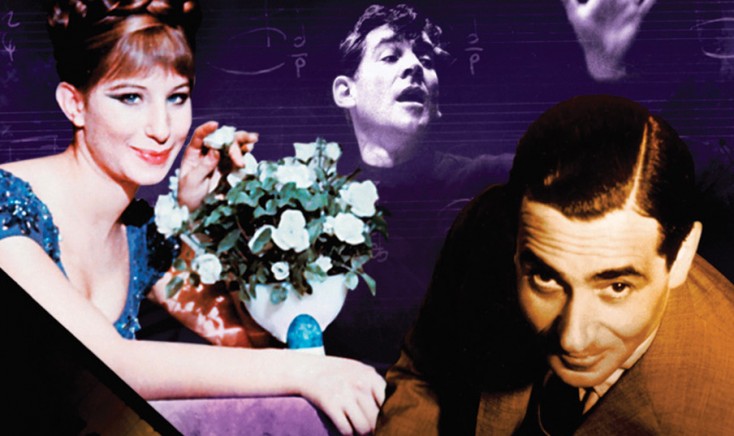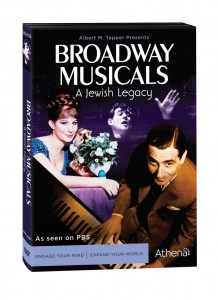By ANGELA DAWSON
Front Row Features
HOLLYWOOD—Michael Kantor, who won an Emmy in 2005 for his “Broadway: The American Musical,” a six-part series hosted by Julie Andrews, is back with yet another look at the Great White Way with “Broadway Musicals: A Jewish Legacy.”
Having explored the history of the New York stage in-depth in the award-winning series, the filmmaker was ready to move on. That’s when he received a call from producer Barbara Brilliant who asked him why he hadn’t explored how the Jewish culture had influenced the birth of that American art form. Kantor responded that he thought it would be a whole separate story and perhaps someone else should tell it. Also, getting the rights to use the music and performance clips would be expensive, and in a tough economy, raising money to make a follow up film would be challenging.
Brilliant was nothing if not persistent. She raised the money and found a way to pull Kantor off of a project he was working on.
“She had the passion for it that I inherited,” he recalls by phone from New York. “If someone in this financial climate goes out and finds money (to finance) it, it makes it much more pleasurable to do because making a documentary is tough.”
“Broadway Musicals: A Jewish Legacy” examines the unique role of Jewish composers and lyricists in the creation of the modern American musical. Kantor serves as director and Brilliant is the executive producer.
Having first aired in January on PBS, the documentary is now available on DVD through Acorn Media. It retails for $39.99. Fascinating and ambitious, it showcases the work of legends such as Irving Berlin, Jerome Kern, George and Ira Gershwin, Lorenz Hart, Richard Rodgers, Oscar Hammerstein II, Leonard Bernstein, Stephen Sondheim and others. Broadway veteran Joel Grey serves as narrator.
“Broadway Musicals: A Jewish Legacy” combines cultural history and interviews with songwriters and luminaries including Sheldon Harnick, Stephen Schwartz, Harold Prince, Arthur Laurents, Charles Strouse and Mel Brooks. Standout performances and footage rarely seen, including a 1964 TV clip of Jerry Bock and Sheldon Harnick performing a still incomplete version of “Tradition” from “Fiddler on the Roof,” are included.
In addition to the 84-minute documentary, the DVD set includes three hours of bonus features on a separate disc. Additional interview clips and performances, a 16-page viewer’s guide featuring reflections on Jewish Broadway with an introduction by Brilliant and a biography of narrator Grey comprise the second disc.
Q: You had so much material for this. How do you decide what to use and what to cut?
Kantor: When I started this project, I thought it would either be a seven-minute story or a seven-hour story. Somehow, we ended up in the middle. There were just so many amazing things that couldn’t be crammed in. I was glad that Acorn Media was really keen to have a whole other disc with for the bonus material.
Q: After making the six-part “Broadway” series, did you considered making this a longer form series?
Kantor: We thought about creating additional 30-minute programs that focused on different composers and lyricists. The thing about music documentaries is that licensing music is really not cheap, both in terms of the music itself and the clips of performances. I don’t know if we could have raised enough money to put together a six or eight hour series. Also, in the same way that the creators of “Fiddler on the Roof” didn’t want to appeal solely to a Jewish Hadassah women’s group audience, we wanted the documentary to have universal appeal. The 90-minute form is nice for one sitting. With the DVD extras, the people who are really engaged can get that much more out of it.
Q: How did you select what in the film?
Kantor: Our organizing principle was that it’s a story of composers and lyricists. Theodore Bikel tells an amazing story that ended up on the cutting room floor, but it’s on the DVD’s extras. He’s not a composer or lyricist but he played Captain von Trapp (on Broadway) in “The Sound of Music.”
Q: The film has funny moments about these composers lives but also tragic moments involving anti-Semitism, like when Charles Strouse (the composer of “Annie” and “Bye Bye Birdie”) recalls being tied to a tree and set on fire when he was young.
Kantor: He wrote, “Put on a Happy Face.” He appears later in the story not only because he was born a little later (than the other composers) but I thought it was really important to not top load this history with tragedy. It’s a joyful art form. It’s a celebration, and it makes people feel good. It was nice that that layer of the story shows up when it does, which is about three-quarters of the way through. Hopefully, by then, the viewers are really engaged and hooked on the evolution and different connections. I’d never heard a story like that. You hear about people being picked on and not getting a job because of prejudice but that’s like out of a movie. It’s horrifying.
Q: Many of the composers in your documentary were newly arrived immigrants or sons of immigrants. Immigration is a hot political issue right now. How recently did you make this?
Kantor: We finished it in late October and it aired on PBS in January. Part of it is that themes (like immigration) are timeless. We weren’t thinking of the current immigration debate. Since the time of “West Side Story,” that’s been a powerful topic for people to argue about and discuss and create laws over. We wanted to choose the stories that connected most strongly with today’s audience—whether it was a story from the 1920s or a story from the 1980s.
Q: Was there something that came up in making this that surprised you?
Kantor: Seeing Sheldon Harnick and Jerry Bock in the footage we use, which I don’t think has been seen on television since it originally aired in 1964, was really kind of staggering to see because we think of “Fiddler on the Roof” as this monumental achievement that’s been around the world a million times. We forget that there was a moment where they were deciding this song or that song and this lyric or that lyric. That was a real joy. The other thing that surprised me was when Joel Grey signed on as narrator was that he had this history. His father, Mickey Katz, specialized in writing Jewish parody songs. He’d sing, “Home on the Range” in Yiddish. So Joel really connected with the material and he brought something special to it. You can hear it in his reading. He made a couple of suggestions, which we took. I was keen to tell stories I hadn’t told in the “Broadway” series. Kurt Weill and Jule Styne—those are two titans of the Broadway musical that weren’t mentioned in the series, but they get their due in this.
Q: Why didn’t you include Marvin Hamlisch?
Kantor: I did an interview with Marvin Hamlisch for the Broadway series and could have used portions of that. But we spoke on the phone about two or three months before he died. I’d been pestering him for an interview. I told him “You’ve got to be part of this.” His feeling was anything that would draw the public’s attention to Jewish achievement could also become the focus of pushback, where people could take an anti-Semitic stance. He said he didn’t want to be associated with anything that ‘s patting itself on the back or breast-beating or saying, “Look at these terrific achievements that we, the Jewish people, have had.” I tried to explain to him (that the documentary was) about a cultural history. It spans 70 years or so, and it’s not saying, “This guy was great and this guy wasn’t.” We included (non-Jewish composer) Cole Porter. But I understand his point of view. It was late in his life. I think he knew he was terminally ill so I didn’t think it was appropriate to use an older interview just to include him.
Q: “Fiddler on the Roof” was a bit of a turning point where it was about Jewish characters depicting a specifically Jewish experience.
Kantor: Originally, I was thinking the film should end with “Fiddler on the Roof,” because if Irving Berlin saw a pogrom destroy his house (in what is now Belarus) and comes to America and he goes to a Broadway theater where he sees other people who’ve dramatized that exact type of story as high art, isn’t that a nice narrative arc? After that, is there much to say? But as one of our commentators says, “You’ve made it. You’re accepted by society. Now what?” There are other challenges and stories that continued after 1964.
Q: Do you think you’ll continue to explore Broadway? What other stories are you interested in telling?
Kantor: I’m always interested in Broadway stories. There’s always more to tell. Right now, I’m finishing a three-part history on superheroes. It’s called “Superheroes: A Never-Ending Battle.” I’m looking at how, out of the Great Depression, sprang these characters, which, coincidentally, had predominantly Jewish creators. The creators of Superman, Jerry Siegel and Joe Shuster, were Jewish. It’s interesting one follows the other. That will come out on PBS in October.






